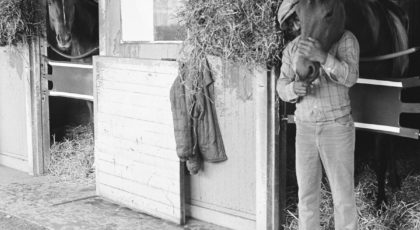After nearly four decades of horse ownership, I’ve finally come to a realization: horsekeeping is not a science, but rather an art.
Sure, I’d prefer it was the other way around. Wouldn’t we all? Just feed X amount of Y feed, allow Z amount of turnout time, and everything will be spectacular!
But, alas, it’s not so simple. And despite the vast amount of resources available to horse owners these days, determining what works best for your horse(s) may take quite a bit of trial and error.
Where I live in Oklahoma, for instance, we have the problem of too much grass. (Some of you may be wondering how this is a problem exactly, but trust me on this). Too much grass is wonderful for baling hay, but it can also spell major problems for certain horses—namely, my two easy keeper mares.
To remedy this situation, I’ve tried various tactics:
Using grazing muzzles

Photo provided by the author
These little contraptions can be great for some horses. (I had a gelding who did fine in one.) But other horses just get pissy or downright depressed. And if you use a muzzle, be prepared to get looks of horror from non-horse people who may happen by. You’ll have to explain that no, the horse isn’t Hannibal Lecter—he’s just on a diet.
A dry lot

Photo provided by the author
Where I live, this translates to making a small pen of mostly dirt, which grass and weeds soon overtake. The horses were bored, and even with hay, still tried to snag whatever scant morsels of grass they could find. Basically, it was a fail.
Keeping my horses in stalls/pens part-time

Photo provided by the author
Part-time penning can actually work well, but the horses need regular exercise to make up for all that standing around. Plus, there are downsides to keeping horses stalled (such as increased likelihood of colic and stereotypical behavior). I’d rather not do this if I don’t have to.
A track system, aka Paddock Paradise

In theory (and in reality for many people), the “paddock paradise,” made popular by Jamie Jackson, helps encourage movement while restricting grass intake by mimicking the living conditions of wild horses. If you live in a fairly arid and varied environment (or have lots of money/resources to create an artificially varied environment), track systems can work beautifully. But when you have a flat, grassy pasture, it doesn’t always work so well. Even if you turn under the grass, it’s just going to come back. (I prefer not to use grass-killing chemicals).
What I ended up with was a track full of short, stressed grass, which basically defeated the entire purpose of the system. Plus, my horses preferred standing in the barn to actually moving around the track much, so reluctantly, I took it down.
Forgoing pasture mowing

Going au naturale my grass wouldn’t be stressed and the horses could eat exactly what they wanted. The result? Two very fat mares and a pasture that looked more like an eyesore.
For the moment, I’ve struck a happy medium. I’ve decided to mow again, but not super short. I’m also rotating pastures. This way, the horses can graze the smaller one in the growing season and have the bigger one in the fall and winter. Will I change my mind and try something different in the future?
Most likely.
But that’s what horsekeeping is all about. Determining what works best for your horses, and making changes when you feel the need to.
There will never be a shortage of people out there telling you their way is the best way. And maybe it is for them. But your situation may be different. I advise all horse owners to keep an open mind. Do your research. Use common sense. But don’t be afraid to try new things. After all, horsekeeping is an art, not a science.
About the Author
Casie Bazay is a freelance and young adult writer, as well as an owner/barefoot trimmer and certified equine acupressure practitioner. She hosts the blog, The Naturally Healthy Horse, where she regularly shares information on barefoot, equine nutrition, and holistic horse health. Once an avid barrel racer, Casie now enjoys just giving back to the horses who have given her so much.


 August 9, 2017
August 9, 2017 




























